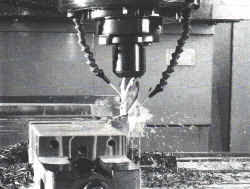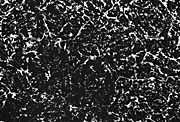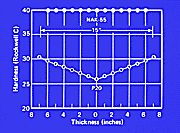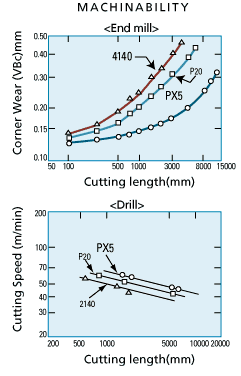Article
High-Performance Mold Steels

By Thomas Schade, Vice President, International Mold Steel, Inc.
In the past 30 years there have been tremendous improvements in machine and cutting tool technologies. High-speed machining can accomplish cutting speeds and accuracies that toolmakers in the past could only dream of.
Advances in cutting tool metallurgy and coatings technology have dramatically improved tool life. However, toolmakers still limit their ability to take full advantage of these marvelous technological advances by using a mold steel that was developed in the 1950s: P-20.

Given a cheap and familiar steel, why switch? Because there is a better way to make molds. In the past few years mold steels have been developed that are easier to machine and weld. One of these new materials is a precipitation hardening steel of uniform microstructure and hardness that was developed by Professor Asada and Dr. Watanabe of Daido Industrial College in Nagoya, Japan. This material was introduced to the plastics industry as NAK 80.
Although NAK 80 is considerably harder than P-20 (40 Rockwell C compared with 32 Rockwell C for P-20), it machines 15-20 percent faster than P-20 and can be polished to a Class 1 optic-quality finish. To further improve machinability, a small amount of sulfur was added to NAK 80 to produce a new grade of steel called NAK 55. Some NAK 55 users report as much as 50 percent reduction in machining time compared to P-20. There are several reasons for the increased metal removal rates for NAK 55 over P-20. NAK 55 is a vacuum arc remelted, age-hardened steel. As such, it is exceptionally clean with very uniform grain structure and hardness from surface to core.
What this means to the mold builder is:
You will never hit a hard spot and break an expensive finishing cutter.
You never need to do an intermediate stress relief. The dimensional stability of NAK 55 is such that if there is any movement during machining it will be measured by .0001 of an inch.
Increased cutting tool life.
PROCESSING GUIDELINES
The optimum cutting conditions for NAK 55 vary by machine tools. Cutting tools incorporating the recommended geometries will produce superb finish machined surfaces, often completely eliminating grinding. NAK 55 does not work harden.
Milling: High-speed steel cutters give excellent results and very smooth machined surfaces. The best result will be obtained with cutter geometry incorporating a positive rake angle of 15 degrees–20 degrees and a relief angle of less than 10 degrees.

NAK 55 Grain Structure

NAK 55 Hardness Curve
Carbide cutting tools (P-40 grade) yield excellent results if the positive rake angle of the inserts is approximately 8 degrees and the relief angle is less than 10 degrees. When a negative rake carbide is used, insert grades with greater toughness than P-40 will give better results. In general, a positive rake configuration is superior to negative rake for milling NAK 55. Small, single flute carbide cutters will give excellent results.
Grinding: NAK 55 grinds easily. It is recommended that it be ground wet.
Drilling: NAK 55 drills easily. The cutting speed should be lowered as drill diameter increases. A smaller than standard twist angle and shorter length will reduce the danger of broken tools.
Tapping: NAK 55 is a 40 HRc steel; therefore the following is recommended to facilitate tapping:
Use a sharp, premium grade tap, tin coated and spiral pointed.
Use a tapping oil or highly chlorinated sulfurized oil. If neither is available, a mixture of 50 percent kerosene and 50 percent cutting oil also works well.
EDM: Copper or graphite electrodes are suitable, or the steel may be used as an electrode when burning mating halves together to achieve a matched fit. The recast layer from EDM for NAK 55 is soft (approximately 32 HRc). Other low alloy grades, such as P-20, or more highly alloyed steels such as S7 and H13, have extremely hard recast layers equivalent to 55–60 Rockwell C. Because the EDM white layer must be removed, the subsequent stoning or grinding of NAK 55 is much easier than with other steels.
The success of NAK 80 and NAK 55 is only partially attributable to excellent machinability. Usually a mistake in the mold or part design must be corrected by welding. It is very difficult to weld, polish and retexture the surface of P-20 without the welded area being visible in the steel of the molded part. If the mistake occurs in a highly polished textured area, the entire cavity may need to be scrapped. The mold made from NAK, when the proper procedures and NAK-W weld rods are used, will have uniform hardness across the weld. This allows the toolmaker to purposefully match the polish or etch.
A tooling engineer from Apple Computer (Cupertino, CA), explains: “In today’s business environment, to shorten time-to-market, we are usually forced to build molds while the parts are being designed. This means we make a lot of changes to our molds, both during the construction and after the first tryout. Our ability to make these changes with NAK, sometimes in an already textured area, has saved us countless times. We have also found that NAK etches much better than other mold steels.” Design changes can be made during the life of a part as well.
MISTAKE-PROOF STEEL: PX5
In 1989, the Daido team of engineers surveyed the mold building industry to identify what mold builders considered their worst reoccurring problem. The resounding response was “welding”. Perfect welds are obtainable with the NAK series of mold steels. But, proper pre- and post-heating is required. According to the mold builders surveyed, a pre-hardening steel that doesn’t crack when welded at room temperature, and could be repolished or retextured without post, would be ideal.
In 1993, Daido introduced a new pre-hardened mold steel called PX5 that combines the weldability and machinability of NAK with added toughness. PX5 has the same hardness as P-20 (32 Rockwell C) but is more consistent through the entire workpiece. The steel’s tensile and yield strengths are similar to NAK and P-20 (see chart).
A quench and temper heat-treating process is used to manufacture PX5, but the steel is quite stable. It can be machined to size without the need to relieve stress on the block before the finish cut. The sacrifice in hardness for NAK (40 Rockwell C) is compensated for by extreme toughness. PX5 is 60 percent tougher than P-20. This improved toughness allows increased design creativity and flexibility. But it’s the weldability that really makes PX5 unique.
Welding this steel requires neither pre-heating nor post-heating, which greatly reduces welding time and cost. According to Ernie Beutel, vice president of Technical Services for International Mold Steel, “the increase in hardness in the area heated during welding is very low and distortion is minimal, resulting in low overall repair time and cost. As with NAK steels, the weld can be textured or polished with no observable difference in the surface. As with NAK 55, the use of positive rake cutters will always give superior results when cutting PX5. Consistent hardness and the elimination of hard spots will improve tool life.”
Ron Field, process development engineer for the Makino Die/Mold Division, decided to put PX5 to the test. Field compared the machinability of PX5 to P-20 by machining Makino waves on a Makino V55 vertical machining center. Roughing the P-20 took 102 minutes. Roughing the PX5 took 56 minutes. The superior machined finish obtainable with PX5 practically looked polished. A major mold base manufacturer obtained similar results.

When Roland Krevitt, program manager for Apple Computer specified the mold steel for the 20th anniversary Macintosh, he chose PX5. “I used PX5 and was amazed by its performance. Machining time was reduced by 30 percent, stress relieving was never required and welds in critical areas textured perfectly,” said Krevitt.
“The 20th anniversary Mac was a high-profile launch—it had to be perfect. I knew we would have to weld extensively. The design was in a constant state of flux. PX5 was the only choice. I still laugh when I think of a comment made by one of the CNC operators involved in the project: ‘After machining PX5, I realized that putting P-20 on my Makino is like putting kerosene in my Corvette.’”
Source: Competitive Mold Maker, Volume 4, Number 2
Copyright © 1999 Makino Inc. All rights reserved.